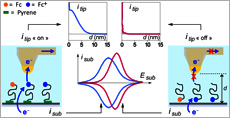Publication
742
Phys. Chem. Chem. Phys., 16 (10), 4642-4652, 2014
DOI:10.1039/C3CP54720E
|
|
|
|
|
|

|
Where is the foot, where is the head? |
|
Probing the conformation and 2D-distribution of pyrene-terminated redox-labeled poly(ethylene glycol) chains end-adsorbed on HOPG using cyclic voltammetry and atomic force electrochemical microscopy. |
|
|
|
Agnès Anne, Mohamed Ali Bahri, Arnaud Chovin, Christophe Demaille, and Cécilia Taofifenua
Laboratoire d'Electrochimie Moléculaire, UMR 7591 CNRS, Univ Paris Diderot, Sorbonne Paris Cité, 15 rue Jean-Antoine de Baïf, F-75205 Paris Cedex 13, France
The present paper aims at illustrating how end-attachment of water-soluble flexible chains bearing a terminal functional group onto graphene-like surfaces has to be carefully tuned to ensure the proper positioning of the functional moiety with respect to the anchoring surface. The model experimental system considered here consists of a layer of poly(ethylene glycol) (PEG) chains, bearing an adsorbing pyrene foot and a ferrocene (Fc) redox functional head, self-assembled onto highly oriented pyrolytic graphite (HOPG). Cyclic voltammetry is used to accurately measure the chain coverage and gain insights into the microenvironment experienced by the Fc heads. Molecule-touching atomic force electrochemical microscopy (Mt/AFM-SECM) is used to simultaneously probe the chain conformation and the position of the Fc heads within the layer, and also to map the 2D-distribution of the chains over the surface. This multiscale electrochemical approach allows us to show that whereas Fc–PEG–pyrene readily self-assembles to form extremely homogeneous layers, the strongly hydrophobic nature of graphite planes results in a complex coverage-dependent structure of the PEG layer due to the interaction of the ferrocene label with the HOPG surface. It is shown that, even though pyrene is known to adsorb particularly strongly onto HOPG, the more weakly adsorbing terminal ferrocene can also act as the chain anchoring moiety especially at low coverage. However we show that beyond a critical coverage value the Fc–PEG–pyrene chains adopt an ideal “foot-on” end-attached conformation allowing the Fc head to explore a volume away from the surface solely limited by the PEG chain elasticity. |

